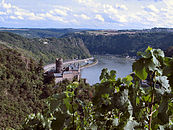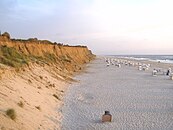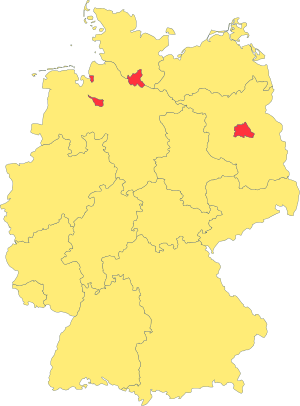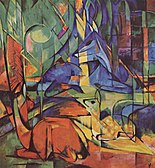User:Oaholroyd/sandbox
Template:Featured article is only for Wikipedia:Featured articles. 51°N 9°E / 51°N 9°E
Federal Republic of Germany Bundesrepublik Deutschland[a] | ||
|---|---|---|
| Anthem: President of the Federal Constitutional Court | Andreas Voßkuhle | |
| Legislature | ||
• Bundesrat | ||
| Bundestag | ||
| Formation | ||
| 2 February 962 | ||
| 8 June 1815 | ||
| 18 January 1871 | ||
| 11 August 1919 | ||
| 23 May 1949 | ||
| 1 January 1958 | ||
| 3 October 1990 | ||
| Area | ||
• Total | 357,168 km2 (137,903 sq mi) (63rd) | |
| Population | ||
• 2015 estimate | 81,459,000[2] (16th) | |
• Density | 227/km2 (587.9/sq mi) (58th) | |
| GDP (PPP) | 2015 estimate | |
• Total | $3.842 trillion[3] (5th) | |
• Per capita | $47,033[3] (20th) | |
| GDP (nominal) | 2015 estimate | |
• Total | $3.371 trillion[3] (4th) | |
• Per capita | $41,267[3] (20th) | |
| Gini (2014) | medium | |
| HDI (2014) | very high (6th) | |
| Currency | Euro (€) (EUR) | |
| Time zone | UTC+1 (CET) | |
• Summer (DST) | UTC+2 (CEST) | |
| Driving side | right | |
| Calling code | 49 | |
| ISO 3166 code | DE | |
| Internet TLD | .de and .eu | |
Germany (/ˈdʒɜːrməni/; German: Deutschland [ˈdɔʏtʃlant]), officially the Federal Republic of Germany (German: Bundesrepublik Deutschland, ⓘ),[e][6] is a federal parliamentary republic in West-Central Europe. It includes 16 constituent states and covers an area of 357,021 square kilometres (137,847 sq mi) with a largely temperate seasonal climate. Its capital and largest city is Berlin. With about 81.5 million inhabitants, Germany is the most populous member state in the European Union. After the United States, it is the second most popular migration destination in the world.[7]
Various
The rise of
In the 21st century, Germany is a
Germany was a founding member of the European Union in 1993. It is part of the
Etymology
The English word Germany derives from the Latin
History
The discovery of the
Germanic tribes and Frankish Empire

The
In the 3rd century a number of large West Germanic tribes emerged:
Holy Roman Empire
For 900 years, the history of Germany was intertwined with the history of the
The
In the 12th century, under the
Population declined in the first half of the 14th century, starting with the

In 1517, the
In the 18th century, the Holy Roman Empire consisted of approximately 1,800
German Confederation and Empire
Following the fall of
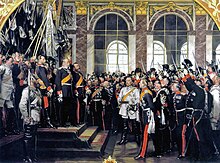
King William I appointed Otto von Bismarck as the new Minister President of Prussia in 1862. Bismarck successfully concluded war on Denmark in 1864, which promoted German over Danish interests in the Jutland peninsula. The subsequent (and decisive) Prussian victory in the Austro-Prussian War of 1866 enabled him to create the North German Confederation (Norddeutscher Bund) which excluded Austria from the federation's affairs. After the French defeat in the Franco-Prussian War, the German princes proclaimed the founding of the German Empire in 1871 at Versailles, uniting all scattered parts of Germany except Austria. Prussia was the dominant constituent state of the new empire; the Hohenzollern King of Prussia ruled as its concurrent Emperor, and Berlin became its capital.[35]
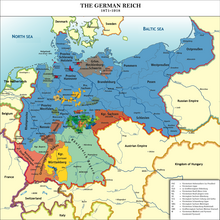
In the [
The
Weimar Republic and Nazi era
Germany was declared a
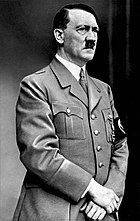
The
Using deficit spending, a government-sponsored program for economic renewal focused on public works projects. In public work projects of 1934, 1.7 million Germans immediately were put to work, which gave them an income and social benefits.
In 1935, the regime withdrew from the Treaty of Versailles and introduced the
In the spring of 1940, Germany
In what later became known as
East and West Germany
After Germany surrendered, the Allies partitioned Berlin and Germany's remaining territory into four military occupation zones. The western sectors, controlled by France, the United Kingdom, and the United States, were merged on 23 May 1949 to form the Federal Republic of Germany (Bundesrepublik Deutschland); on 7 October 1949, the Soviet Zone became the German Democratic Republic (Deutsche Demokratische Republik). They were informally known as "West Germany" and "East Germany". East Germany selected East Berlin as its capital, while West Germany chose Bonn as a provisional capital, to emphasise its stance that the two-state solution was an artificial and temporary status quo.[66]
West Germany was established as a federal parliamentary republic with a "

East Germany was an
Tensions between East and West Germany were reduced in the early 1970s by Chancellor
German reunification and the EU
The united Germany is considered to be the enlarged continuation of the Federal Republic of Germany and not a
The modernisation and integration of the eastern German economy is a long-term process scheduled to last until the year 2019, with annual transfers from west to east amounting to roughly $80 billion.[75]
Based on the
Since reunification, Germany has taken a more active role in the
Germany sent a peacekeeping force to secure stability in the
In the
In 2009, a
Germany was affected by the
Geography

Germany is in
Elevation ranges from the mountains of the Alps (highest point: the Zugspitze at 2,962 metres or 9,718 feet) in the south to the shores of the North Sea (Nordsee) in the northwest and the Baltic Sea (Ostsee) in the northeast. The forested uplands of central Germany and the lowlands of northern Germany (lowest point: Wilstermarsch at 3.54 metres or 11.6 feet below sea level) are traversed by such major rivers as the Rhine, Danube and Elbe. Germany's alpine glaciers are experiencing deglaciation. Significant natural resources include iron ore, coal, potash, timber, lignite, uranium, copper, natural gas, salt, nickel, arable land and water.[1]
Climate
Most of Germany has a
The east has a more continental climate: winters can be very cold and summers very warm, and longer dry periods can occur. Central and southern Germany are transition regions which vary from moderately oceanic to continental. In addition to the maritime and continental climates that predominate over most of the country, the Alpine regions in the extreme south and, to a lesser degree, some areas of the Central German Uplands have a mountain climate, with lower temperatures and greater precipitation.[85]
Biodiversity
The territory of Germany can be subdivided into two

Plants and animals include those generally common to Central Europe. Beeches, oaks, and other deciduous trees constitute one-third of the forests; conifers are increasing as a result of reforestation. Spruce and fir trees predominate in the upper mountains, while pine and larch are found in sandy soil. There are many species of ferns, flowers, fungi, and mosses. Wild animals include
The 14
Urbanization
Germany has a number of large
| Rank | Name
|
State | Pop. | Rank | Name
|
State | Pop. | ||
|---|---|---|---|---|---|---|---|---|---|
| 1 | Berlin | Berlin | 3,644,826 | 11 | Bremen | Bremen | 569,352 | ||
| 2 | Hamburg | Hamburg | 1,841,179 | 12 | Dresden | Saxony | 554,649 | ||
| 3 | Munich | Bavaria | 1,471,508 | 13 | Hanover | Lower Saxony | 538,068 | ||
| 4 | Cologne | North Rhine-Westphalia | 1,085,664 | 14 | Nuremberg | Bavaria | 518,365 | ||
| 5 | Frankfurt | Hesse | 753,056 | 15 | Duisburg | North Rhine-Westphalia | 498,590 | ||
| 6 | Stuttgart | Baden-Württemberg | 634,830 | 16 | Bochum | North Rhine-Westphalia | 364,628 | ||
| 7 | Düsseldorf | North Rhine-Westphalia | 619,294 | 17 | Wuppertal | North Rhine-Westphalia | 354,382 | ||
| 8 | Leipzig | Saxony | 587,857 | 18 | Bielefeld | North Rhine-Westphalia | 333,786 | ||
| 9 | Dortmund | North Rhine-Westphalia | 587,010 | 19 | Bonn | North Rhine-Westphalia | 327,258 | ||
| 10 | Essen | North Rhine-Westphalia | 583,109 | 20 | Münster | North Rhine-Westphalia | 314,319 | ||
Politics
 |
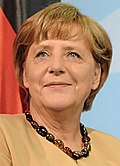
|
| Joachim Gauck President since 2012 |
Angela Merkel Chancellor since 2005 |
Germany is a
The

The chancellor,
Since 1949, the party system has been dominated by the
The
Law

Germany has a
Criminal and private laws are codified on the national level in the
Constituent states
Germany comprises sixteen federal states which are collectively referred to as Bundesländer.
|
Foreign relations

Germany has a network of 227 diplomatic missions abroad
The development policy of Germany is an independent area of foreign policy. It is formulated by the Federal Ministry for Economic Cooperation and Development and carried out by the implementing organisations. The German government sees development policy as a joint responsibility of the international community.[113] It is the world's third biggest aid donor in 2009 after the United States and France.[114][115]
In 1999, Chancellor Gerhard Schröder's government defined a new basis for German foreign policy by taking part in the NATO decisions surrounding the Kosovo War and by sending German troops into combat for the first time since 1945.[116] The governments of Germany and the United States are close political allies.[35] Cultural ties and economic interests have crafted a bond between the two countries resulting in Atlanticism.[117]
Military
Germany's military, the Bundeswehr, is organised into
As of December 2015[update] the Bundeswehr employed roughly 178,000 soldiers, including 9,500 volunteers.
In peacetime, the Bundeswehr is commanded by the Minister of Defence. In
The role of the Bundeswehr is described in the
Until 2011, military service was compulsory for men at age 18, and conscripts served six-month tours of duty; conscientious objectors could instead opt for an equal length of Zivildienst (civilian service), or a six-year commitment to (voluntary) emergency services like a fire department or the Red Cross. In 2011 conscription was officially suspended and replaced with a voluntary service.[126][127]
Economy

Germany has a
The
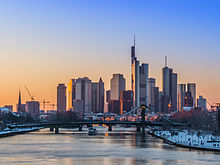
Germany is part of the
Being home to the modern car, the automotive industry in Germany is regarded as one of the most competitive and innovative in the world,[137] and is the fourth largest by production.[138] The top 10 exports of Germany are vehicles, machineries, chemical goods, electronic products, electrical equipments, pharmaceuticals, transport equipments, basic metals, food products, and rubber and plastics.[139]
Companies
Of the world's 500 largest stock-market-listed companies measured by revenue in 2014, the
Germany is recognised for its large portion of specialised
The list includes the largest German companies by revenue in 2011:[143]
| Rank | Name | Headquarters | Revenue (mil. €) |
Profit (mil. €) |
Employees (world) |
|---|---|---|---|---|---|
| 1. | Volkswagen | Wolfsburg | 159,000 | 15,800 | 502,000 |
| 2. | E.ON | Düsseldorf | 113,000 | −1,900 | 79,000 |
| 3. | Daimler |
Stuttgart | 107,000 | 6,000 | 271,000 |
| 4. | Siemens | München |
74,000 | 6,300 | 360,000 |
| 5. | BASF | Ludwigshafen | 73,000 | 6,600 | 111,000 |
| 6. | BMW | München |
69,000 | 4,900 | 100,000 |
| 7. | Metro | Düsseldorf | 67,000 | 740 | 288,000 |
| 8. | Schwarz Gruppe | Neckarsulm | 63,000 | N/A | 315,000 |
| 9. | Deutsche Telekom | Bonn | 59,000 | 670 | 235,000 |
| 10. | Deutsche Post | Bonn | 53,000 | 1,300 | 471,000 |
| — | Allianz | München |
104,000 | 2,800 | 141,000 |
| — | Deutsche Bank | Frankfurt | 21,600 | 4,300 | 101,000 |
Transport
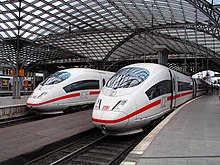
With its central position in Europe, Germany is a transport hub for the continent.[144] Like its neighbours in Western Europe, Germany's road network is amongst the densest in the world.[145] The motorway (Autobahn) network ranks as the third-largest worldwide in length and is known for its lack of a general speed limit.[146]
Germany has established a polycentric network of
The largest German airports are
Energy and infrastructure
In 2008[update], Germany was the world's sixth-largest consumer of energy,
Science and technology

Germany's achievements in the sciences have been significant, and research and development efforts form an integral part of the economy.[160] The Nobel Prize has been awarded to 104 German laureates.[161] In the beginning of the 20th century, German laureates had more awards than those of any other nation, especially in the sciences (physics, chemistry, and physiology or medicine).[162][163]
Notable German physicists before the 20th century include
.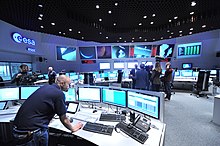
Germany has been the home of many
Research institutions in Germany include the
Tourism
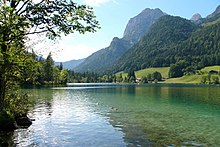
Germany is the seventh most visited country in the world,[171][172] with a total of 407 million overnights during 2012.[173] This number includes 68.83 million nights by foreign visitors. In 2012, over 30.4 million international tourists arrived in Germany. Berlin has become the third most visited city destination in Europe.[174] Additionally, more than 30% of Germans spend their holiday in their own country, with the biggest share going to Mecklenburg-Vorpommern. Domestic and international travel and tourism combined directly contribute over EUR43.2 billion to German GDP. Including indirect and induced impacts, the industry contributes 4.5% of German GDP and supports 2 million jobs (4.8% of total employment).[175]
Germany is well known for its diverse tourist routes, such as the
Demographics

With a population of 80.2 million according to the 2011 census,
Four sizable groups of people are referred to as "national minorities" because their ancestors have lived in their respective regions for centuries.
Approximately 5 million Germans live abroad.[189]
Immigrant population
In 2014, about seven million of Germany's 81 million residents did not have German citizenship. Ninety-six percent of these people lived in western Germany and mostly in urban areas.[191] [192]
In the 1960s and 1970s, the German governments invited "guest workers" (Gastarbeiter) to migrate to Germany for work in the German industries. Many companies preferred to keep these workers employed in Germany after they had trained them and Germany's immigrant population has steadily increased. As of 2011, about six million foreign citizens (7.7% of the population) were registered in Germany.[180]
The
In 2006, the
Religion
According to the
Geographically, Protestantism is concentrated in the northern, central and eastern parts of the country. These are mostly members of the EKD, which encompasses
In 2011, 33% of Germans declared themselves to be
Other religions comprising less than one percent of Germany's population[198] are Buddhism with 250,000 adherents (roughly 0.3%) and Hinduism with some 100,000 adherents (0.1%). All other religious communities in Germany have fewer than 50,000 adherents each.[202]
Languages

German is the official and predominant spoken language in Germany.[203] It is one of 24 official and working languages of the European Union,[204] and one of the three working languages of the European Commission. German is the most widely spoken first language in the European Union, with around 100 million native speakers.[205]
Recognized native minority languages in Germany are
Education
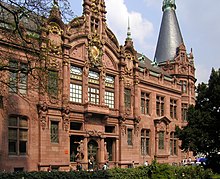
Responsibility for educational supervision in Germany is primarily organised within the individual
Most of the German universities are public institutions, and students have traditionally studied without fee payment.[212] The general requirement for university is the Abitur, a qualification normally based on continuous assessment during the last few years at school and final examinations. However, there are a number of exceptions, depending on the state, the university and the subject. Academic education is open to international students and is increasingly common.[213]
In the
Health

Germany's system of hospices, called spitals, dates from medieval times, and today, Germany has the world's oldest
In 2010[update], the principal cause of death was cardiovascular disease, at 41%, followed by malignant tumours, at 26%.[218] In 2008[update], about 82,000 Germans had been infected with HIV/AIDS and 26,000 had died from the disease (cumulatively, since 1982).[219] According to a 2005 survey, 27% of German adults are smokers.[219] Obesity in Germany has been increasingly cited as a major health issue. A 2007 study shows Germany has the highest number of overweight people in Europe.[220][221]
Culture
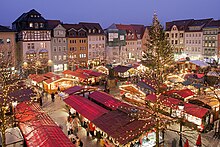
From its roots, culture in German states has been shaped by major intellectual and popular currents in Europe, both religious and secular. Historically Germany has been called Das Land der Dichter und Denker ("the land of poets and thinkers"),[222] because of the major role its writers and philosophers have played in the development of Western thought and culture. People with German
Germany is well known for such folk festival traditions as
In the 21st century Berlin has emerged as a major international creative center.[228] According to the Anholt–GfK Nation Brands Index, in 2014 Germany was the world's most respected nation among 50 countries (ahead of USA, UK, and France).[229][230][231] A global opinion poll for the BBC revealed that Germany is recognised for having the most positive influence in the world in 2013 and 2014.[232][233]
Music

Symphony No. 5
German
Germany is the second largest music market in Europe, and fourth largest in the world.
Art
German painters have influenced western art. Albrecht Dürer, Hans Holbein the Younger, Matthias Grünewald and Lucas Cranach the Elder were important German artists of the Renaissance, Peter Paul Rubens and Johann Baptist Zimmermann of the Baroque, Caspar David Friedrich and Carl Spitzweg of Romanticism, Max Liebermann of Impressionism and Max Ernst of Surrealism.[238] Such German sculptors as Otto Schmidt-Hofer, Franz Iffland, and Julius Schmidt-Felling made important contributions to German art history in the late 19th and early 20th centuries.[239][240]
Several German artist groups formed in the 20th century, such as the November Group or Die Brücke (The Bridge) and Der Blaue Reiter (The Blue Rider), by the Russian-born Wassily Kandinsky, influenced the development of Expressionism in Munich and Berlin. The New Objectivity arose as a counter-style to it during the Weimar Republic. Post-World War II art trends in Germany can broadly be divided into Neo-expressionism, performance art and Conceptualism. Especially notable neo-expressionists include or included Georg Baselitz, Anselm Kiefer, Jörg Immendorff, A. R. Penck, Markus Lüpertz, Peter Robert Keil and Rainer Fetting. Other notable artists who work with traditional media or figurative imagery include Martin Kippenberger, Gerhard Richter, Sigmar Polke, and Neo Rauch. Leading German conceptual artists include or included Bernd and Hilla Becher, Hanne Darboven, Hans-Peter Feldmann, Hans Haacke, Joseph Beuys, HA Schult, Aris Kalaizis, Neo Rauch (New Leipzig School) and Andreas Gursky (photography). Major art exhibitions and festivals in Germany are the documenta, the Berlin Biennale, transmediale and Art Cologne.[238]
Architecture
Architectural contributions from Germany include the
Vernacular architecture in Germany is often identified by its timber framing (Fachwerk) traditions. German Fachwerk building styles vary across regions, and among carpentry styles. Planning laws dictate that a half-timbered house must be authentic to regional or even city-specific designs before being accepted.[242][243]
When industrialisation spread across Europe,
Literature and philosophy

German literature can be traced back to the Middle Ages and the works of writers such as Walther von der Vogelweide and Wolfram von Eschenbach. Well-known German authors include Johann Wolfgang von Goethe, Friedrich Schiller, Gotthold Ephraim Lessing and Theodor Fontane. The collections of folk tales published by the Brothers Grimm popularised German folklore on an international level.[247] The Grimms also gathered and codified regional variants of the German language, grounding their work in historical principles; their Deutsches Wörterbuch, or German Dictionary, sometimes called the Grimm dictionary, was begun in 1838 and the first volumes published in 1854.[248]
Influential authors of the 20th century include Gerhart Hauptmann, Thomas Mann, Hermann Hesse, Heinrich Böll and Günter Grass.[249] German-speaking book publishers produce some 700 million books every year, with about 80,000 titles, nearly 60,000 of them new. Germany comes third in quantity of books published, after the English and Chinese speaking book markets.[250] The Frankfurt Book Fair is the most important in the world for international deals and trading, with a tradition spanning over 500 years,[251] also the Leipzig Book Fair retains a major position in Europe.[252]
German philosophy is historically significant:
Media
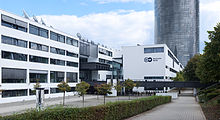
The largest internationally operating
Many of Europe's best-selling newspapers and magazines are produced in Germany. The papers (and internet portals) with the highest circulation are Bild (a tabloid), Die Zeit, Süddeutsche Zeitung, Frankfurter Allgemeine Zeitung and Die Welt, the largest magazines include Der Spiegel, Stern and Focus.[257]
The
Cinema
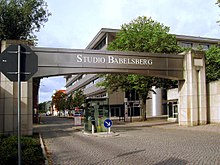
After 1945, many of the films of the immediate post-war period can be characterised as
During the 1970s and 1980s,
The annual
Cuisine
German cuisine varies from region to region and often neighboring regions share some culinary similarities (e.g. the southern regions of
are also popular and available, thanks to diverse ethnic communities.Bread is a significant part of German cuisine and German bakeries produce about 600 main types of bread and 1,200 different types of pastries and rolls (Brötchen). German cheeses account for about a third of all cheese produced in Europe.[269] In 2012 over 99% of all meat produced in Germany was either pork, chicken or beef. Germans produce their ubiquitous sausages in almost 1,500 varieties, including Bratwursts, Weisswursts, and Currywursts.[270] In 2012, organic foods accounted for 3.9% of total food sales.[271]
Although wine is becoming more popular in many parts of Germany, especially in German wine regions,[272] the national alcoholic drink is beer. German beer consumption per person stands at 110 litres (24 imp gal; 29 US gal) in 2013 and remains among the highest in the world.[273] German beer purity regulations date back to the 15th century.[274]
The
Sports

Twenty-seven million Germans are members of a sports club and an additional twelve million pursue sports individually.[278] Association football is the most popular sport. With more than 6.3 million official members, the German Football Association (Deutscher Fußball-Bund) is the largest sports organisation of its kind worldwide, and the German top league, the Bundesliga, attracts the second highest average attendance of all professional sports leagues in the world.[278] The German men's national football team won the FIFA World Cup in 1954, 1974, 1990, and 2014 and the UEFA European Championship in 1972, 1980 and 1996. Germany hosted the FIFA World Cup in 1974 and 2006 and the UEFA European Championship in 1988.
Other popular spectator sports include
Germany is one of the leading motor sports countries in the world. Constructors like BMW and Mercedes are prominent manufacturers in motor sport. Porsche has won the 24 Hours of Le Mans race 17 times, and Audi 13 times (as of 2015). The driver Michael Schumacher has set many motor sport records during his career, having won more Formula One World Drivers' Championships with seven titles, than any other. He is one of the highest paid sportsmen in history.[279] Sebastian Vettel is also among the top three most successful Formula One drivers of all time.[280]
Historically,
Fashion and design

German designers were leaders of modern product design, with the Bauhaus designers like Mies van der Rohe, and Dieter Rams of Braun being essential.[283]
Germany is a leading country in the
Munich, Hamburg and Düsseldorf are also important design, production and trade hubs of the domestic fashion industry, among smaller towns.
See also
- Index of Germany-related articles
- Outline of Germany
Notes
- ^ In recognized minority languages of Germany:
- Danish: Forbundsrepublikken Tyskland
- Low German: Bundesrepubliek Düütschland
- Upper Sorbian: Zwjazkowa Republika Němska
- Lower Sorbian: Nimska Zwězkowa Republika
- Vlax Romani: Federalni Republika Jermaniya
- West Frisian: Bûnsrepublyk Dútslân
- ^ Only the third stanza of the song is used as the national anthem.
- ^ Danish, Low German, Sorbian, Romany, and Frisian are recognised by the European Charter for Regional or Minority Languages
- ^ European Union since 1993.
- ^ IPA transcription of "Bundesrepublik Deutschland": [ˈbʊndəsʁepuˌbliːk ˈdɔʏtʃlant]
- ^ The map includes information for the non-member states Bosnia and Herzegovina, Switzerland and Turkey.
References
- ^ a b c d e f g "Germany". CIA World Factbook. Central Intelligence Agency. Archived from the original on 11 February 2016. Retrieved 30 August 2014.
- ^ "Population based on the 2011 Census - Federal Statistical Office (Destatis)". destatis.de. 26 January 2016.
- ^ a b c d "Germany". International Monetary Fund. October 2015. Retrieved October 2015.
{{cite web}}: Check date values in:|accessdate=(help) - ^ "Gini coefficient of equivalised disposable income (source: SILC)". Eurostat Data Explorer. Retrieved 13 August 2013.
- ^ "2015 Human Development Report" (PDF). United Nations Development Programme. 2015. Retrieved 14 December 2015.
- ISBN 978-3-411-20916-3.
- ^ "Germany Top Migration Land After U.S. in New OECD Ranking". Bloomberg. 20 May 2014. Retrieved 29 August 2014.
- ISBN 978-3-406-47638-9.
- ^ ISBN 9781107020733.
- ^ "How US students get a university degree for free in Germany". BBC. 3 June 2015. Retrieved 13 November 2015.
- ISBN 0-674-80688-3.
- ISBN 3-525-20768-9. (for diutisc) Lloyd, Albert L.; Lühr, Rosemarie; Springer, Otto (1998). Etymologisches Wörterbuch des Althochdeutschen, Band II (in German). Vandenhoeck & Ruprecht. pp. 685–686.ISBN 3-525-20768-9. (for diot)
- ^ "Radiometric dating of the type-site for Homo heidelbergensis at Mauer, Germany". PNAS. 27 August 2010. Archived from the original on 1 January 2015. Retrieved 27 August 2010.
- ^ "World's Oldest Spears". archive.archaeology.org. 3 May 1997. Retrieved 27 August 2010.
- ^ "Earliest music instruments found". BBC. 25 May 2012. Retrieved 25 May 2012.
- ^ "Ice Age Lion Man is world's earliest figurative sculpture". The Art Newspaper. 31 January 2013. Archived from the original on 15 February 2015. Retrieved 31 January 2013.
- ^ "The Venus of Hohle Fels". donsmaps.com. 14 May 2009. Retrieved 14 May 2009.
- ^ "Nebra Sky Disc". Unesco memory of the World. 2013.
- ISBN 0-8147-1381-5.
- ^ ISBN 978-0-521-36836-0, pp. 9–13.
- ISBN 0-521-30199-8.
- ^ The lumping of Germanic people into the generic term 'Germans' has its roots in the Investiture Controversy according to historian Herwig Wolfram, who claimed it was a defensive move made by the papacy to delineate them as outsiders, partly due to the papacy's insecurity and so as to justify counterattacks upon them. See: Wolfram, Herwig (1997). 'The Roman Empire and its Germanic Peoples. California University Press. pp. 11–13.
- ^ a b Fulbrook 1991, p. 11.
- ^ McBrien, Richard (2000). Lives of the Popes: The Pontiffs from St. Peter to Benedict XVI. HarperCollins. p. 138.
- ^ Fulbrook 1991, pp. 13–24.
- ^ Fulbrook 1991, p. 27.
- ^ Nelson, Lynn Harry. The Great Famine (1315–1317) and the Black Death (1346–1351). University of Kansas. Retrieved 19 March 2011.
- ^ Eisenstein, Elizabeth. (1980). The printing press as an agent of change. Cambridge University Press, pp. 3–43.
- ^ S2CID 40773221.
- ISBN 978-0-631-18117-0.
- ^ For a general discussion of the impact of the Reformation on the Holy Roman Empire, see Hajo Holborn, A History of Modern Germany, The Reformation, Princeton N.J., Princeton University Press, 1959, chapters 6–9 (pp. 123–248).
- ^ Gagliardo, G (1980). Reich and Nation, The Holy Roman Empire as Idea and Reality, 1763–1806. Indiana University Press. pp. 12–13.
- ^ Fulbrook 1991, p. 97.
- .
- ^ a b c d e f g h i "Germany". U.S. Department of State. 10 November 2010. Retrieved 26 March 2011.
- ISBN 978-1-4027-2885-3.
- ^ Fulbrook 1991, pp. 135, 149.
- ^ Crossland, David (22 January 2008). "Last German World War I Veteran Believed to Have Died". Spiegel Online. Retrieved 25 March 2011.
- ^
Boemeke, Manfred F.; ISBN 978-0-521-62132-8.
- ^
ISBN 978-0-521-62132-8.
- ^
Keylor, William R. (1998). "Versailles and International Diplomacy". In Boemeke, Manfred F.; ISBN 978-0-521-62132-8.
- ^ Fulbrook 1991, pp. 156–160.
- The Rise and fall of the Third Reich, Simon and Schuster (1960) p.31.
- ^ Williamson (2005). Germany since 1815: A Nation Forged and Renewed. Palgrave Macmillan. pp. 186–204.
- ^ "PROLOGUE: Roots of the Holocaust". The Holocaust Chronicle. Retrieved 28 September 2014.
- ^ Fulbrook 1991, pp. 155–158, 172–177.
- ISBN 978-0-14-303469-8p. 344
- ^ "Ein Konzentrationslager für politische Gefangene In der Nähe von Dachau". Münchner Neueste Nachrichten ("The Munich Latest News") (in German). The Holocaust History Project. 21 March 1933. Archived from the original on 10 May 2000. Retrieved 5 March 2016.
- ^ "Industrie und Wirtschaft" (in German). Deutsches Historisches Museum. Retrieved 25 March 2011.
- ^ McNab, p. 54
- ISBN 978-0-14-303790-3pp. 322–326, 329
- ISBN 9783861531173, pp. 16–17.
- ^ McNab, p. 56
- ^ Fulbrook 1991, pp. 188–189.
- ISBN 978-0-521-53120-7, pp. 143-144.
- ^ a b Fulbrook, pp. 190–195.
- ISBN 978-3-88557-089-9.
- ISBN 978-0-231-11200-0.
- ^ Institute of National Remembrance (Poland), Polska 1939–1945 Straty osobowe i ofiary represji pod dwiema okupacjami. Materski and Szarota. page 9 "Total Polish population losses under German occupation are currently calculated at about 2 770 000".
- ^ a b Maksudov, S. (1994). "Soviet Deaths in the Great Patriotic War: A Note". Europe-Asia Studies 46 (4): 671–680.
- ^ ISBN 0-521-56521-9
- ^ "Leaders mourn Soviet wartime dead". BBC News. 9 May 2005. Retrieved 18 March 2011.
- ISBN 3-486-56531-1.
- ISBN 9780191727603.)
{{cite book}}: CS1 maint: multiple names: editors list (link - ^ Overy, Richard (17 February 2011). "Nuremberg: Nazis on Trial". BBC History. Retrieved 25 March 2011.
- ISBN 978-1-56898-134-5.
- ISBN 0-521-49964-X.)
{{cite book}}: CS1 maint: multiple names: editors list (link - ^ Werner Bührer (24 December 2002). "Deutschland in den 50er Jahren: Wirtschaft in beiden deutschen Staaten" [Economy in both German states]. Informationen zur Politischen Bildung. Bundeszentrale für politische Bildung.
- ^ maw/dpa (11 March 2008). "New Study Finds More Stasi Spooks". Der Spiegel. Retrieved 30 October 2011.
- ^ "Germany (East)", Library of Congress Country Study, Appendix B: The Council for Mutual Economic Assistance
- ^ Protzman, Ferdinand (22 August 1989). "Westward Tide of East Germans Is a Popular No-Confidence Vote". The New York Times. Retrieved 30 October 2011.
- ^ "What the Berlin Wall still stands for". CNN Interactive. 8 November 1999. Retrieved 18 February 2008.
- ^ Vertrag zwischen der Bundesrepublik Deutschland und der Deutschen Demokratischen Republik über die Herstellung der Einheit Deutschlands (Einigungsvertrag) Unification Treaty signed by the Federal Republic of Germany and the German Democratic Republic in Berlin on 31 August 1990 (official text, in German).
- ^ "Vertrag zwischen der Bundesrepublik Deutschland und der Deutschen Demokratischen Republik über die Herstellung der Einheit Deutschlands (Einigungsvertrag) Art 11 Verträge der Bundesrepublik Deutschland" (in German). Bundesministerium für Justiz und Verbraucherschutz. Retrieved 15 May 2015.
- ^ Kulish, Nicholas (19 June 2009). "In East Germany, a Decline as Stark as a Wall". The New York Times. Retrieved 27 March 2011.
- ^ "Gesetz zur Umsetzung des Beschlusses des Deutschen Bundestages vom 20. Juni 1991 zur Vollendung der Einheit Deutschlands" (in German). Bundesministerium der Justiz. 26 April 1994. Retrieved 19 April 2011.
- ^ "Brennpunkt: Hauptstadt-Umzug". Focus (in German). 12 April 1999. Retrieved 19 March 2011.
- ^ "Lisbon Treaty : The making of" (PDF). Council of the European Union. Retrieved 14 June 2011.
After signature by all 27 Heads of State and governments, the Treaty will travel back to Brussels, where it will be officially sealed with the seals of the 27 Member States, on the 18th of December. Then, it will be sent to Rome, the Italian government being the depository of the Treaties.
- ^ Dempsey, Judy (31 October 2006). "Germany is planning a Bosnia withdrawal". International Herald Tribune. Retrieved 7 May 2011.
- ^ Merz, Sebastian (November 2007). "Still on the way to Afghanistan? Germany and its forces in the Hindu Kush" (PDF). Stockholm International Peace Research Institute. pp. 2, 3. Retrieved 16 April 2011.
- ^ "Germany agrees on 50-billion-euro stimulus plan". France 24. 6 January 2009. Archived from the original on 13 May 2011. Retrieved 27 March 2011.
- ^ "Government declaration by Angela Merkel" (in German). ARD Tagesschau. 29 January 2014. Archived from the original on 1 January 2015. Retrieved 15 December 2014.
- ^ "Migrant crisis: Migration to Europe explained in seven charts". BBC News. 28 January 2016. Retrieved 31 January 2016.
- ^ Image #432, Flying Camera Satellite Images 1999 Archived 15 October 2015 at the Wayback Machine, Lloyd Reeds Map Collection, McMaster University Library.
- ^ a b "Climate in Germany". GermanCulture. Retrieved 26 March 2011.
- ^ "Terrestrial Ecoregions". WWF. Archived from the original on 29 October 2010. Retrieved 19 March 2011.
- ^ Strohm, Kathrin (May 2010). "Arable farming in Germany" (PDF). Agri benchmark. Retrieved 14 April 2011.
- ISBN 978-1-58843-503-3.
- ISBN 9789077135044.
The Cornflower was once the floral emblem of Germany (hence the German common name Kaiserblume).
- ^ "Zoo Facts". Zoos and Aquariums of America. Archived from the original on 7 October 2003. Retrieved 16 April 2011.
- ^ "Der Zoologische Garten Berlin" (in German). Zoo Berlin. Archived from the original on 30 April 2011. Retrieved 19 March 2011.
- ^ "Regionales Monitoring 2010 – Daten und Karten zu den Europäischen Metropolregionen in Deutschland" (PDF) (in German). Bundesamt für Bauwesen und Raumordnung. 2010. p. 10. Archived from the original (PDF) on 12 July 2012. Retrieved 11 April 2012.
- ^ "Basic Law for the Federal Republic of Germany" (PDF). Deutscher Bundestag. Btg-bestellservice. October 2010. Retrieved 14 April 2011.
- ^ "Christian Democratic Union/Christian Social Union". U.S. Library of Congress. Retrieved 26 March 2011.
- ^ "World Economic Outlook Database, April 2015, General government gross debt (National currency, Percent of GDP)". International Monetary Fund. April 2015. Retrieved 26 January 2016.
- ^ "Third quarter of 2015 compared with second quarter of 2015 - Government debt fell to 91.6 % of GDP in euro area". Eurostat. 22 January 2016. Retrieved 26 January 2016.
- ^ "German Government Achieves 'Historic' Budget Surplus". The World Street Journal. 13 January 2016. Retrieved 26 January 2016.
- ^ "Reuters: Fitch Affirms Germany at 'AAA'; Outlook Stable". Reuters. 8 January 2016. Retrieved 26 January 2016.
- ^ "Federal Constitutional Court". Bundesverfassungsgericht. Retrieved 25 March 2015.
- ^ "§ 2 Strafvollzugsgesetz" (in German). Bundesministerium der Justiz. Retrieved 26 March 2011.
- ISBN 978-3-936999-51-8.
- S2CID 144941508.
- Bundesrat of Germany. Retrieved 6 May 2015.
- ^ "Example for state constitution: "Constitution of the Land of North Rhine-Westphalia"". Landtag (state assembly) of North Rhine-Westphalia. Archived from the original on 17 January 2013. Retrieved 17 July 2011.
- Statistisches BundesamtDeutschland. October 2014. Retrieved 2 February 2015.
- Statistisches BundesamtDeutschland. August 2013. Retrieved 16 December 2013.
- ^ "The German Missions Abroad". German Federal Foreign Office. Retrieved 7 May 2015.
- ^ "The Embassies". German Federal Foreign Office. Retrieved 18 July 2012.
- ^ "The EU budget 2011 in figures". European Commission. Retrieved 6 May 2011.
- ^ "United Nations regular budget for the year 2011". UN Committee on Contributions. Retrieved 6 May 2011.
- ^ "Declaration by the Franco-German Defence and Security Council". French Embassy UK. 13 May 2004. Archived from the original on 27 March 2014. Retrieved 19 March 2011.
- ^ Freed, John C. (4 April 2008). "The leader of Europe? Answers an ocean apart". The New York Times. Retrieved 28 March 2011.
- ^ "Aims of German development policy". Federal Ministry for Economic Cooperation and Development. 10 April 2008. Archived from the original on 10 March 2011. Retrieved 26 March 2011.
- ^ "Net Official Development Assistance 2009" (PDF). OECD. Retrieved 26 March 2011.
- ^ "Speech by Chancellor Angela Merkel to the United Nations General Assembly". Die Bundesregierung. 21 September 2010. Retrieved 18 March 2011.
- ^ "Germany's New Face Abroad". Deutsche Welle. 14 October 2005. Retrieved 26 March 2011.
- ^ "U.S.-German Economic Relations Factsheet" (PDF). U.S. Embassy in Berlin. May 2006. Archived from the original (PDF) on 11 May 2011. Retrieved 26 March 2011.
- ^ "The 15 countries with the highest military expenditure in 2011". Stockholm International Peace Research Institute. September 2011. Retrieved 7 April 2012.
- ^ "Germany to increase defence spending". IHS Jane's 360. Retrieved 20 January 2016.
- ^ "Die Stärke der Streitkräfte" (in German). Bundeswehr. 10 December 2015. Retrieved 2 January 2016.
- ^ "Ausblick: Die Bundeswehr der Zukunft" (in German). Bundeswehr. Retrieved 5 June 2011.
- ^ "Frauen in der Bundeswehr" (in German). Bundeswehr. Retrieved 14 April 2011.
- ^ "Trends in International Arms Transfer, 2014". www.sipri.org. Stockholm International Peace Research Institute. Retrieved 18 March 2015.
- ^ "Grundgesetz für die Bundesrepublik Deutschland, Artikel 65a,87,115b" (PDF) (in German). Bundesministerium der Justiz. Retrieved 19 March 2011.
- ^ "Einsatzzahlen – Die Stärke der deutschen Einsatzkontingente" (in German). Bundeswehr. Retrieved 11 January 2015.
- ^ Connolly, Kate (22 November 2010). "Germany to abolish compulsory military service". The Guardian. Retrieved 7 April 2011.
- ^ Pidd, Helen (16 March 2011). "Marching orders for conscription in Germany, but what will take its place?". The Guardian. Retrieved 7 April 2011.
- ^ a b "Country Comparison: Exports". The World Factbook. Central Intelligence Agency. Retrieved 10 November 2012.
- ^ "CPI 2009 table". Transparency International. Retrieved 15 May 2012.
- ^ "The Innovation Imperative in Manufacturing: How the United States Can Restore Its Edge" (PDF). Boston Consulting Group. March 2009. Retrieved 19 March 2011.
- ^ "Gross domestic product (2009)" (PDF). The World Bank: World Development Indicators database. World Bank. 27 September 2010. Retrieved 1 January 2011.
Field listing – GDP (official exchange rate) Archived 27 December 2018 at the Wayback Machine - ^ "Gross domestic product (2009)" (PDF). The World Bank: World Development Indicators database. World Bank. 27 September 2010. Retrieved 5 October 2010.
Field listing – GDP (PPP exchange rate) Archived 4 June 2011 at the Wayback Machine - ^ a b Eurostat: Euro area unemployment rate at 11.2%, Press release of 2 March 2015
- ^ "Labour productivity levels in the total economy". OECD. Retrieved 12 December 2014.
- ^ Andrews, Edmund L. (1 January 2002). "Germans Say Goodbye to the Mark, a Symbol of Strength and Unity". The New York Times. Retrieved 18 March 2011.
- St. Petersburg Times. p. National, 1.A.
- ^ Germany – The World's Automotive Hub of Innovation, Germany Trade & Invest, Ernst & Young European Automotive Survey 2013, retrieved 25 April 2015
- ^ "Production Statistics - OICA". oica.net.
- ^ "CIA Factbook". Retrieved 23 April 2015.
- ^ "Best Global Brands - 2014 Rankings". Interbrand. Archived from the original on 15 March 2015. Retrieved 26 March 2015.
- ^ Gavin, Mike (23 September 2010). "Germany Has 1,000 Market-Leading Companies, Manager-Magazin Says". Businessweek. Archived from the original on 30 April 2011. Retrieved 27 March 2011.
- ^ Frost, Simon (28 August 2015). "Berlin outranks London in start-up investment". euractiv.com. Retrieved 28 October 2015.
- ^ "Global 500: Countries – Germany". Forbes. 26 July 2010. Retrieved 27 March 2011.
- ^ "Assessment of strategic plans and policy measures on Investment and Maintenance in Transport Infrastructure" (PDF). International Transport Forum. 2012. Retrieved 15 March 2014.
- ^ "Road density (km of road per 100 sq. km of land area)". World Bank. 2014. Archived from the original on 1 January 2015. Retrieved 7 July 2014.
- ^ "Autobahn-Temporegelung" (Press release) (in German). ADAC. June 2010. Retrieved 19 March 2011.
- ^ "Geschäftsbericht 2006" (in German). Deutsche Bahn. Archived from the original on 9 August 2007. Retrieved 27 March 2011.
- ^ "German Railway Financing" (PDF). p. 2.
- ^ "Airports in Germany". Air Broker Center International. Retrieved 16 April 2011.
- ^ "Top World Container Ports". The official website of the Port of Hamburg. Port of Hamburg authority. Archived from the original on 5 May 2015. Retrieved 6 May 2015.
- ^ "Overview/Data: Germany". U.S. Energy Information Administration. 30 June 2010. Retrieved 19 April 2011.
- ^ "Energy imports, net (% of energy use)". The World Bank Group. Retrieved 18 April 2011.
- ^ Ziesing, Hans-Joachim. "Energieverbrauch in Deutschland im Jahr 2014" (PDF) (in German). AG Energiebilanzen. p. 4. Retrieved 10 March 2015.
- ^ "Germany split over green energy". BBC News. 25 February 2005. Retrieved 27 March 2011.
- ^ "Germany greenest country in the world". The Times of India. 21 June 2008. Archived from the original on 28 April 2011. Retrieved 26 March 2011.
- ^ "Deutschland erfüllte 2008 seine Klimaschutzverpflichtung nach dem Kyoto-Protokoll" (Press release) (in German). Umweltbundesamt. 1 February 2010. Retrieved 8 May 2015.
- ^ ISSN 0099-9660. Retrieved 9 November 2015.
- ^ "Record High 2010 Global Carbon Dioxide Emissions from Fossil-Fuel Combustion and Cement Manufacture Posted on CDIAC Site". Carbon Dioxide Information Analysis Center. Archived from the original on 8 May 2012. Retrieved 15 May 2012.
- ^ Federal Ministry for the Environment (29 March 2012). Langfristszenarien und Strategien für den Ausbau der erneuerbaren Energien in Deutschland bei Berücksichtigung der Entwicklung in Europa und global [Long-term Scenarios and Strategies for the Development of Renewable Energy in Germany Considering Development in Europe and Globally] (PDF). Berlin, Germany: Federal Ministry for the Environment (BMU).
- ^ "Federal Report on Research and Innovation 2014" (PDF). Federal Ministry of Education and Research. 2014. Archived from the original (PDF) on 14 May 2016. Retrieved 26 March 2015.
- ^ "Nobel Prize". Nobelprize.org. Retrieved 27 March 2011.
- ^ "Swedish academy awards". ScienceNews. Retrieved 1 October 2010.
- ^ National Science Nobel Prize shares 1901–2009 by citizenship at the time of the award and by country of birth. From Schmidhuber, J. (2010). "Evolution of National Nobel Prize Shares in the 20th century". Retrieved 27 March 2011.
- ISBN 978-0-7139-9611-1.
- ^ "The First Nobel Prize". Deutsche Welle. 8 September 2010. Retrieved 27 March 2011.
- ^ Bianchi, Luigi. "The Great Electromechanical Computers". York University. Retrieved 17 April 2011.
- ^ "The Zeppelin". U.S. Centennial of Flight Commission. Archived from the original on 1 May 2011. Retrieved 7 May 2015.
- ^ "Historical figures in telecommunications". International Telecommunication Union. 14 January 2004. Retrieved 27 March 2011.
- ^ "Preparations for operation of Wendelstein 7-X starting". PhysOrg. 13 May 2014. Retrieved 12 December 2014.
Max Planck Institute for Plasma Physics (IPP) in Greifswald in May started the preparations for operation of this the world's largest fusion device of the stellarator type.
- ^ "Gottfried Wilhelm Leibniz Prize". DFG. Archived from the original on 21 June 2008. Retrieved 27 March 2011.
- ^ "Interim Update" (PDF). UNWTO World Tourism Barometer. UNWTO. April 2011. Archived from the original (PDF) on 1 January 2015. Retrieved 26 June 2011.
- UNWTO. 2010. Archived from the original (PDF) on 4 March 2016. Retrieved April 2011.)
{{cite web}}: Check date values in:|accessdate=(help - ^ Zahlen Daten Fakten 2012 (in German), German National Tourist Board
- ^ "Tourism Highlights 2014 edition" (PDF). UNWTO. Archived from the original (PDF) on 14 February 2015. Retrieved 26 March 2015.
- ^ "2013 Travel & Tourism Economic Impact Report Germany" (PDF). WTTC. Archived from the original (PDF) on 3 December 2013. Retrieved 26 November 2013.
- ISBN 978-3-921548-37-0.
- ^ Heinrich Edel: 1928. Die Fachwerkhäuser der Stadt Braunschweig: ein kunst und kulturhistorisches Bild. Druckerei Appelhaus, 1928
- ^ "Top Tourist Attractions of Germany". Germany.Travel, official site. Retrieved 12 December 2014.
- ^ "The World Factbook". cia.gov.
- ^ a b Zensus 2011: Bevölkerung am 9. Mai 2011. Retrieved 1 June 2013.
- ^ "Population based on the 2011 Census - German Statistical Office ("Destatis")". destatis.de.
- ^ "Significant population growth to at least 81.9 million in 2015 - German Statistical Office ("Destatis")". destatis.de.
- ^ "Country Comparison :: Population". CIA. Archived from the original on 6 January 2012. Retrieved 26 June 2011.
- ^ "Demographic Transition Model". Barcelona Field Studies Centre. 27 September 2009. Retrieved 28 March 2011.
- ^ "Birth rate on the rise in Germany". The Local. Retrieved 28 September 2014.
- ^ "The New Guest Workers: A German Dream for Crisis Refugees". Spiegel Online. 28 February 2013. Retrieved 28 September 2014.
- ^ "More skilled immigrants find work in Germany". Deutsche Welle. Retrieved 28 September 2014.
- ^ a b c "National Minorities in Germany" (PDF). Federal Ministry of the Interior (Germany). May 2010. Article number: BMI10010. Archived from the original (PDF) on 21 April 2013. Retrieved 23 June 2014.
- ^ Auswärtiges Amt Berlin, Konsular Info. Auswärtiges Amt, Berlin. Accessed 17 June 2015.
- ^ a b "International Migration 2006" (PDF). UN Department of Economic and Social Affairs. Retrieved 18 March 2011.
- ^ "German population rises thanks to immigration". Deutsche Welle. Retrieved 28 September 2014.
- ^ "Population and employment: Population with migrant background – Results of the 2010 microcensus" (PDF). 13 March 2012. Retrieved 28 September 2014.
- ^ "20% of Germans have immigrant roots". Burlington Free Press. 15 July 2010. p. 4A.
- ^ "Publikation — STATmagazin — Population — Families with a migrant background: traditional values count — Federal Statistical Office (Destatis)". Destatis.de. 13 March 2012. Retrieved 4 November 2012.
- ^ "Bevölkerung nach Migrationshintergrund" (in German). German Federal Statistical Office. Archived from the original on 29 December 2010. Retrieved 28 March 2011.
- ^ "Fewer Ethnic Germans Immigrating to Ancestral Homeland". Migration Information Source. February 2004. Retrieved 19 July 2014.
- ^ Pressekonferenz „Zensus 2011 – Fakten zur Bevölkerung in Deutschland" am 31. Mai 2013 in Berlin
- ^ a b c "Bevölkerung im regionalen Vergleich nach Religion (ausführlich) -in %-". destatis.de (Zensusdatenbank des Zensus 2011) (in German). Federal Statistical Office of Germany. 9 May 2011. p. Zensus 2011 – Page 6. Archived from the original on 21 June 2013. Retrieved 9 May 2011.
- ^ "Eastern Germany: the most godless place on Earth | Peter Thompson | Comment is free | guardian.co.uk". London: Guardian. 22 September 2012. Retrieved 22 September 2012.
- ^ a b "Germany". Berkley Center for Religion, Peace, and World Affairs. Archived from the original on 24 March 2015. Retrieved 27 March 2015.
- ISBN 978-3-9812115-1-1. Archived from the original(PDF) on 30 April 2011. Retrieved 28 March 2011.
- ^ "Religionen in Deutschland: Mitgliederzahlen" (in German). Religionswissenschaftlicher Medien- und Informationsdienst. 31 October 2009. Retrieved 28 March 2011.
- ^ a b European Commission (2006). "Special Eurobarometer 243: Europeans and their Languages (Survey)" (PDF). Europa (web portal). Retrieved 28 March 2011.
European Commission (2006). "Special Eurobarometer 243: Europeans and their Languages (Executive Summary)" (PDF). Europa (web portal). Retrieved 28 March 2011. - ^ European Commission. "Official Languages". Retrieved 29 July 2014.
- ISBN 3-9805843-1-3.
- ^ European Commission (2004). "Many tongues, one family. Languages in the European Union" (PDF). Europa (web portal). Archived from the original (PDF) on 30 April 2011. Retrieved 28 March 2011.
- ^ "Sprechen Sie Deutsch?". The Economist. 18 March 2010. Retrieved 16 April 2011.
- ^ Björn Bertram. "Rankings: Universität Heidelberg in International Comparison". Retrieved 28 September 2014.
- ^ a b "Country profile: Germany" (PDF). Library of Congress. April 2008. Retrieved 28 March 2011.
- ^ "The Educational System in Germany". Cuesta College. 31 August 2002. Archived from the original on 24 July 2011. Retrieved 16 May 2011.
- ^ "A German model goes global". Financial Times. Retrieved 28 September 2014.
{{cite web}}: Unknown parameter|registration=ignored (|url-access=suggested) (help) - ^ Tim Pitman; Hannah Forsyth (18 March 2014). "Should we follow the German way of free higher education?". The Conversation. Retrieved 17 March 2014.
- ^ Von Markus Verbeet (18 July 2011). "Mehr Studienanfänger denn je: Jetzt kommt die Flut". Spiegel Online (in German). Retrieved 17 March 2014.
- ^ "Top 100 World Universities". Academic Ranking of World Universities. Archived from the original on 22 August 2008. Retrieved 28 March 2011.
- ^ "Hospital of the Holy Spirit Lübeck". Lübeck + Travemünde. Retrieved 12 December 2014.
- ^ Health Care Systems in Transition: Germany (PDF). European Observatory on Health Care Systems. 2000. p. 8. AMS 5012667 (DEU). Retrieved 15 April 2011.
- ^ a b "Germany statistics summary (2002 - present)". World Health Organization. Retrieved 8 May 2015.
- ^ "2010: Herz-/Kreislauferkrankungen verursachen 41 % aller Todesfälle" (in German). Destatis.de. Retrieved 8 May 2015.
- ^ a b "Country Profile Germany" (PDF). Library of Congress Federal Research Division. April 2008. Retrieved 7 May 2011.
This article may incorporate text from this source, which is in the public domain. - ^ "Topping the EU Fat Stats, Germany Plans Anti-Obesity Drive". Deutsche Welle. 20 April 2007. Retrieved 25 June 2010.
- ^ "Germany launches obesity campaign". BBC. 9 May 2007. Retrieved 25 June 2010.
- ^ Wasser, Jeremy (6 April 2006). "Spätzle Westerns". Spiegel Online International. Retrieved 28 March 2011.
- ^ "Germany country profile". BBC. 25 February 2015. Retrieved 17 May 2015.
- ^ MacGregor, Neil (28 September 2014). "The country with one people and 1,200 sausages". BBC. Retrieved 11 December 2014.
- ^ "Christmas Traditions in Austria, Germany, Switzerland". German Ways. Retrieved 12 December 2014.
- ^ "World Heritage Sites in Germany". UNESCO. Retrieved 3 October 2010.
- ^ "Artikel 2 EV - Vertrag zwischen der Bundesrepublik Deutschland und der Deutschen Demokratischen Republik über die Herstellung der Einheit Deutschlands (Einigungsvertrag - EV k.a.Abk.)" (in German). buzer.de. Retrieved 15 May 2015.
- ^ Sifton, Sam (31 December 1969). "Berlin, the big canvas". The New York Times. Retrieved 18 August 2008. See also: "Sites and situations of leading cities in cultural globalisations/Media". GaWC Research Bulletin 146. Retrieved 18 August 2008.
- ^ "Germany Knocks USA off Best Nation Top Spot After 5 Years" (Press release). GfK. 12 November 2014. Retrieved 16 June 2015.
- German Foreign Office. 13 November 2014. Retrieved 16 June 2015.
- ^ "Achtung! Germany named world's favorite country". USA Today. 18 November 2014. Retrieved 16 June 2015.
- ^ "BBC poll: Germany most popular country in the world". BBC. 23 May 2013. Retrieved 28 March 2011.
- ^ "World Service Global Poll: Negative views of Russia on the rise". BBC.co.uk. 4 June 2014. Retrieved 15 July 2014.
- ^ "Top 100 living geniuses". The Daily Telegraph. London. 30 October 2007. Retrieved 15 May 2015.
- ^ "The Recorded Music Industry In Japan" (PDF). Recording Industry Association of Japan. 2013. p. 24. Retrieved 8 February 2014.
- ^ "Kraftwerk maintain their legacy as electro-pioneers". Deutsche Welle. 8 April 2011. Retrieved 14 May 2013.
- ^ Nye, Sean. "Minimal Understandings: The Berlin Decade, The Minimal Continuum, and Debates on the Legacy of German Techno". Journal of Popular Music Studies, Volume 25, Issue 2. Retrieved 12 December 2014.
- ^ a b Marzona, Daniel. (2005) Conceptual Art. Cologne: Taschen. Various pages
- ^ Berman, Harold (1974). Bronzes, Sculptors & Founders - Signatures (Vol. 2 ed.). Chicago, Illinois: Abage Publishers. p. 477.
- ISBN 0-90746-245-6.
- ^ Jan Koppmann, "Das Zeitalter des Barock", in M. Thierer (ed.), Lust auf Barock: Himmel trifft Erde in Oberschwaben, Lindenberg: Kunstverlag Fink, 2002, p. 11f.
- ^ Wilhelm Süvern: 1971. Torbögen und Inschriften lippischer Fachwerkhäuser in Volume 7 of Heimatland Lippe. Lippe Heimatbund: 1971. 48 pages
- ISBN 978-3-89678-589-3. 160 pages
- ^ "Art Nouveau — Art Nouveau Art". Huntfor.com. Retrieved 25 March 2013.
- ISBN 0-19-860678-8.
- ISBN 978-3836500913.
- ^ Dégh, Linda (1979). "Grimm's Household Tales and its Place in the Household". Western Folklore 38 (2): 85–103, pp. 99–101. (subscription required)
- ^ History of the Deutsches Wörterbuch from the DWB 150th Anniversary Exhibition and Symposium, Berlin: Humboldt-Universität, 2004. (in German), retrieved 27 June 2012.
- ^ Espmark, Kjell (3 December 1999). "The Nobel Prize in Literature". Nobelprize.org. Retrieved 28 March 2011.
- ^ "Land of ideas". Land-der-ideen.matrix.de. Archived from the original on 27 April 2011. Retrieved 19 March 2011.
- ISBN 978-1-55002-744-0.
- ^ Chase, Jefferson (13 March 2015). "Leipzig Book Fair: Cultural sideshow with a serious side". Deutsche Welle. Retrieved 25 April 2015.
- ^ Searle, John (1987). "Introduction". The Blackwell Companion to Philosophy. Wiley-Blackwell.
- ^ "Distribution of TV in Germany (German)". Astra Sat. 19 February 2013. Retrieved 10 December 2014.
- ^ "Country profile: Germany". BBC News. Retrieved 28 March 2011.
- ^ "Organization 1950-1954". Deutsche Welle. Retrieved 15 May 2015.
- ^ "ZDB OPAC - start/text". d-nb.de. Archived from the original on 14 July 2006. Retrieved 1 April 2015.
- ^ Purchese, Robert (17 August 2009). "Germany's video game market". Eurogamer.net. Retrieved 4 March 2012.
- ^ "Press releases". gamescom Press Center. 2014. Archived from the original on 10 February 2015. Retrieved 26 March 2015.
- PC GamesHardware. 27 November 2011. Retrieved 9 December 2014.
- ^ Studio Babelsberg – Mit der Erschließung des direkt in der Nachbarschaft befindlichen Filmgeländes mit den Studios Neue Film 1 und Neue Film 2 konnte Studio Babelsberg seine Studiokapazitäten verdoppeln und verfügt so über Europas größten zusammenhängenden Studiokomplex., retrieved 3 December 2013 (German)
- ^ "SciFi Film History – Metropolis (1927)". Archived from the original on 10 October 2017. Retrieved 28 September 2014.
- ISBN 978-0-07-115141-2.
- ISBN 1441159010.
- ISBN 1571134689
- ^ "Awards:Das Leben der Anderen". IMDb. Retrieved 28 March 2011.
- ^ "2006 FIAPF accredited Festivals Directory" (PDF). International Federation of Film Producers Associations. Retrieved 28 March 2011.
- ^ Die Beauftragte der BUndesregierung fuer Kultur und Medien, Deutscher-flimpreis. Accessed 21 May 2015.
- ^ The Complete Idiot's Guide to Cheeses of the World - Steve Ehlers, Jeanette Hurt. pp. 113-115.
- ^ "Guide to German Hams and Sausages". German Foods North America. Retrieved 26 March 2015.
- ^ "Numbers, data, facts about the organic food sector" (in German). Foodwatch. Retrieved 4 June 2015.
Bio-Produkte machen lediglich 3,9 Prozent des gesamten Lebensmittelumsatzes in Deutschland aus (2012).
- ^ "German Wine Statistics". Wines of Germany, Deutsches Weininstitut. Archived from the original on 14 December 2014. Retrieved 14 December 2014.
- ^ Samantha Payne (20 November 2014). "Top 10 Heaviest Beer-drinking Countries: Czech Republic and Germany Sink Most Pints". Retrieved 6 May 2015.
- ^ spiegel.de/international/germany
- ^ "Michelin Guide restaurants for Germany". Retrieved 26 January 2015.
- ^ "German cuisine beats Italy, Spain in gourmet stars". Reuters. 28 March 2011. Retrieved 19 March 2011.
- ^ "Schnitzel Outcooks Spaghetti in Michelin Guide". Deutsche Welle. 15 November 2007. Retrieved 6 April 2012.
- ^ a b c "Germany Info: Culture & Life: Sports". Germany Embassy in Washington, D.C. Archived from the original on 30 April 2011. Retrieved 28 March 2011.
- ^ Ornstein, David (23 October 2006). "What we will miss about Michael Schumacher". The Guardian. Retrieved 19 March 2011.
- ^ "Vettel makes Formula One history with eighth successive victory". Irish Independent. 17 November 2013.
- ISBN 9780393058840p. 136.
- ^ Large, p. 337.
- ^ "Bauhaus: The Single Most Influential School of Design". gizmodo. 13 June 2012. Retrieved 9 December 2014.
- ^ "BMWI Branchenfokus Textil und Bekleidung". Archived from the original on 21 July 2012. Retrieved 28 September 2014.
- ^ "Berlin as a fashion capital: the improbable rise". Fashion United UK. 12 January 2012. Retrieved 15 May 2015.
- ^ "Die deutsche Mode kommt aus der Provinz". BRIGITTE. Retrieved 28 September 2014.
- ^ "German Cultures Today: Fashion Stars - One Germany in Europe". German History Docs GHDI. Retrieved 26 April 2015.
External links
- Official site of the Federal Government
- Official site of the Federal President
- Official site of the German Chancellor Archived 14 October 2012 at the Wayback Machine
- Deutschland.de – Topical website about Germany
- Official Germany Tourism website
- "Germany". The World Factbook (2024 ed.). Central Intelligence Agency.
- Germany Archived 21 February 2009 at the Wayback Machine at University of Colorado Boulder Libraries
- Oaholroyd/sandbox at Curlie
 Wikimedia Atlas of Germany
Wikimedia Atlas of Germany Geographic data related to Oaholroyd/sandbox at OpenStreetMap
Geographic data related to Oaholroyd/sandbox at OpenStreetMap



